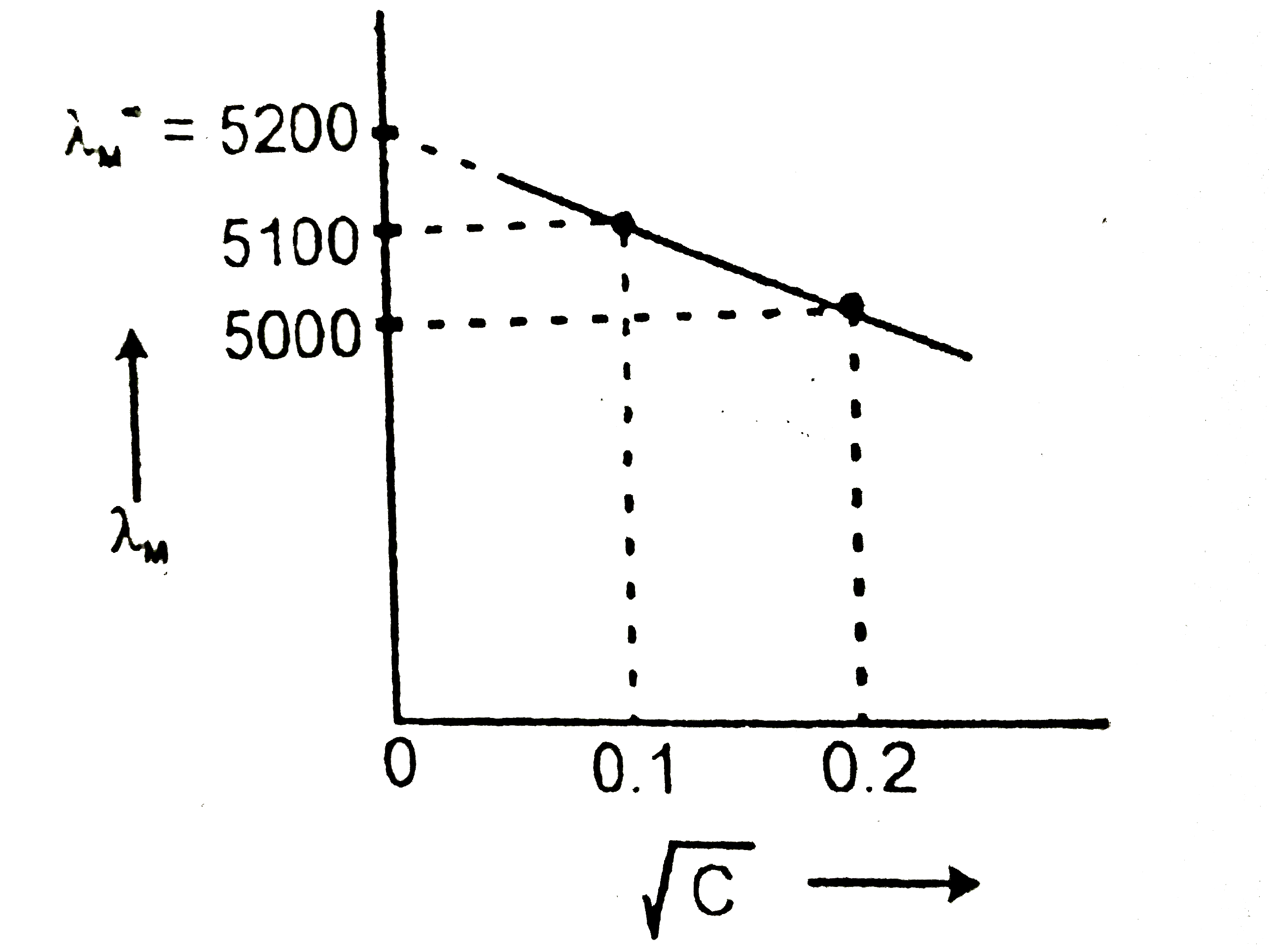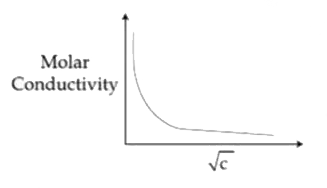When a concentrated solution of an electrolyte is diluted
its specific conductance increases
its equivalent conductivity decreases
its specific conductivity decreases and equivalent conductivity increases
Both specific and equivalent conductivity increases
The correct Answer is:C
To solve the question regarding the effects of diluting a concentrated solution of an electrolyte, we will analyze the concepts of specific conductance and equivalent conductance step by step.
1. Understanding Specific Conductance (κ):
- Specific conductance (κ) is a measure of a solution's ability to conduct electricity. It is defined as the conductance (G) of a solution multiplied by the cell constant (L/A), where L is the distance between the electrodes and A is the area of the electrodes.
- The formula for specific conductance is:
κ=G⋅LA
2. Effect of Dilution on Specific Conductance:
- When a concentrated solution is diluted, the volume of the solution increases. This increase in volume leads to an increase in the area of the electrodes that are dipped into the solution (A).
- Since specific conductance is inversely proportional to the area (A), an increase in area will result in a decrease in specific conductance (κ).
- Therefore, we conclude that:
Specific conductance decreases.
3. Understanding Equivalent Conductance (λ):
- Equivalent conductance (λ) is defined as the specific conductance multiplied by a factor that accounts for the dilution of the solution, specifically the normality (N).
- The formula for equivalent conductance is:
λ=κ⋅1000N
- Here, normality (N) is related to the concentration of the solution.
4. Effect of Dilution on Equivalent Conductance:
- As the solution is diluted, the volume increases, which causes the normality (N) to decrease (since normality is inversely proportional to volume).
- With a decrease in normality (N), and since κ decreases, we need to analyze the relationship:
- If κ decreases and N decreases, the effect on λ depends on the relative changes in κ and N.
- Since N decreases more significantly than κ, the overall effect is that equivalent conductance (λ) increases.
- Therefore, we conclude that:
Equivalent conductance increases.
5. Final Conclusion:
- From the analysis, we find that:
- Specific conductance decreases.
- Equivalent conductance increases.
- Thus, the correct answer to the question is that specific conductivity decreases and equivalent conductivity increases.
Final Answer:
Specific conductivity decreases and equivalent conductivity increases.
---
- Specific conductance (κ) is a measure of a solution's ability to conduct electricity. It is defined as the conductance (G) of a solution multiplied by the cell constant (L/A), where L is the distance between the electrodes and A is the area of the electrodes.
- The formula for specific conductance is:
κ=G⋅LA
- When a concentrated solution is diluted, the volume of the solution increases. This increase in volume leads to an increase in the area of the electrodes that are dipped into the solution (A).
- Since specific conductance is inversely proportional to the area (A), an increase in area will result in a decrease in specific conductance (κ).
- Therefore, we conclude that:
Specific conductance decreases.
- Equivalent conductance (λ) is defined as the specific conductance multiplied by a factor that accounts for the dilution of the solution, specifically the normality (N).
- The formula for equivalent conductance is:
λ=κ⋅1000N
- Here, normality (N) is related to the concentration of the solution.
- As the solution is diluted, the volume increases, which causes the normality (N) to decrease (since normality is inversely proportional to volume).
- With a decrease in normality (N), and since κ decreases, we need to analyze the relationship:
- If κ decreases and N decreases, the effect on λ depends on the relative changes in κ and N.
- Since N decreases more significantly than κ, the overall effect is that equivalent conductance (λ) increases.
- Therefore, we conclude that:
Equivalent conductance increases.
- From the analysis, we find that:
- Specific conductance decreases.
- Equivalent conductance increases.
- Thus, the correct answer to the question is that specific conductivity decreases and equivalent conductivity increases.
Specific conductivity decreases and equivalent conductivity increases.
Topper's Solved these Questions
- BOOK - NARENDRA AWASTHI ENGLISHCHAPTER - ELECTROCHEMISTRYEXERCISE - LEVEL-228videos
ELECTROCHEMISTRY
- BOOK - NARENDRA AWASTHI ENGLISHCHAPTER - ELECTROCHEMISTRYEXERCISE - LEVEL-337videos
ELECTROCHEMISTRY
- BOOK - NARENDRA AWASTHI ENGLISHCHAPTER - DILUTE SOLUTIONEXERCISE - leval-0323videos
DILUTE SOLUTION
- BOOK - NARENDRA AWASTHI ENGLISHCHAPTER - GASEOUS STATEEXERCISE - Subjective problems15videos
GASEOUS STATE
Similar Questions
Why in a concentrated solution, a strong electrolyte shows deviation from Debye − Huckel Onsager equation ?
View SolutionAt 0.04 M concentration, the molar conductivity of solution of an electrolyte is 5000Ω−1cm2mol−1 while at 0.01 M concentration the value is 5100Ω−1cm2mol−1. Making necessary assumption (Taking it as strong electrolyte) find the molar conductivity at infinite dilution and write percentage dissociation of strong electrolyte at 0.04 M.
View SolutionDefine conductivity and molar conductivity for the solution of an electrolyte. Discuss their variation with concentration.
View SolutionFor a 'C'M concentrated solution of a weak electrolyte 'A_(x)B_(y) 'alpha' degree of dissociation) is
View Solution
At 0.04 M concentration the molar conductivity of a solution of a electrolyte is 5000Ω−1cm2mol−1 while at 0.01 M concentration the value is 5100Ω−1cm2mol−1 making necessary assumption (taking it as strong electrolyte) find the molar conductivity at infinite dilution and also determine the degree of dissociation of strong electrolyte at 0.04M.View SolutionThe variation of molar conductivity wih concentration of an electrolyte (X) in aqueous solution is shown in the given figure .

The electrolyte X is :View SolutionAssertion : When a concentrated solution is diluted by adding more water , the number of moles of solute in the solution remains unchanged .
Reason : Number of a solute is equal to the product of molarity and volume of solution in litres.View SolutionWhy can dilute solutions of hydrogen peroxide not be concentrated by heating? How can a conentrated solution of hydrogen peroxide be obtanied ?
View SolutionWhat happens to conductance of solution of a weak electrolyte , when heated
View SolutionAs the dilution of an electrolyte increases
(a) Sepcific conductance decreases
(b)Molar conductance decreases
(c)Resistance increases
(d)No change takes place in conductance As the dilution of an electrolyte increasesView Solution

